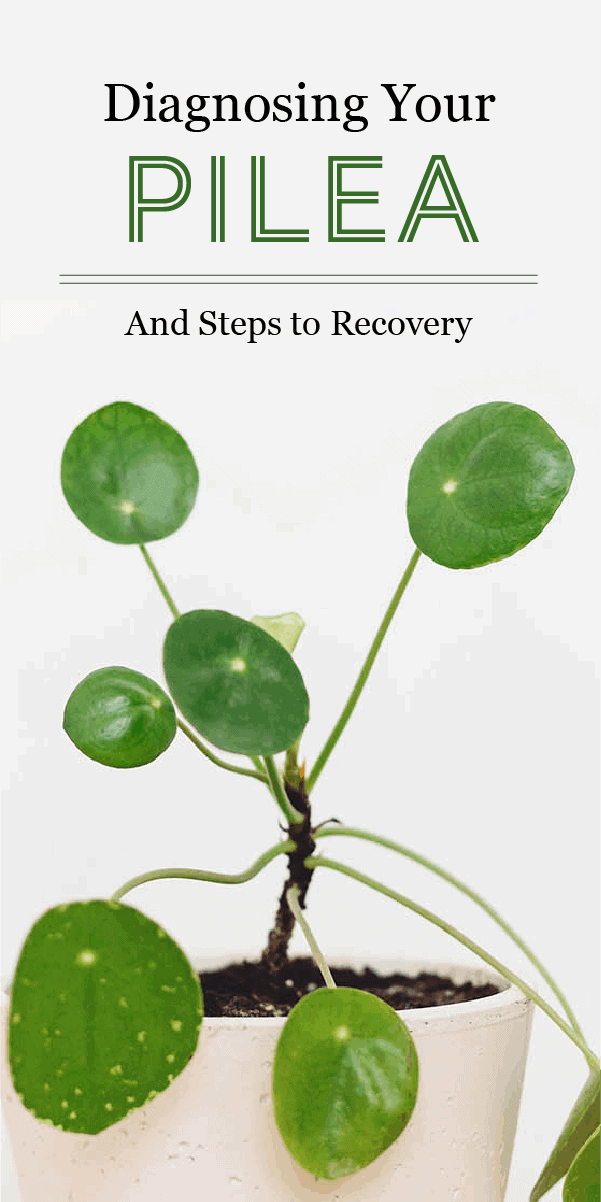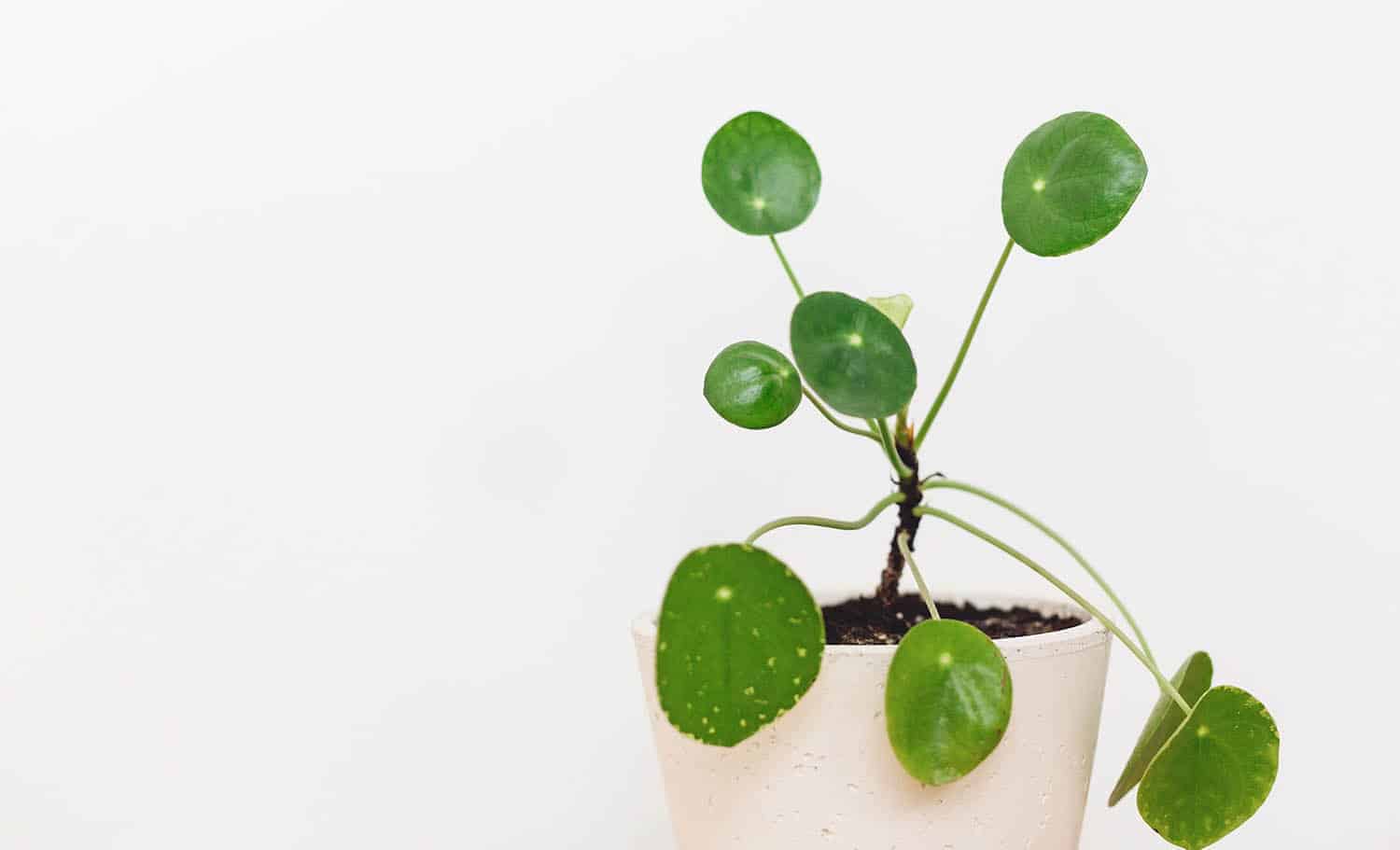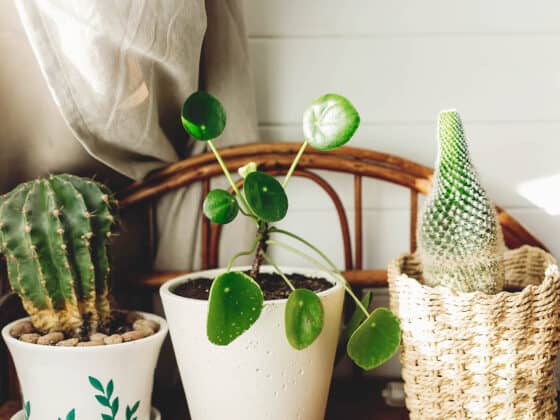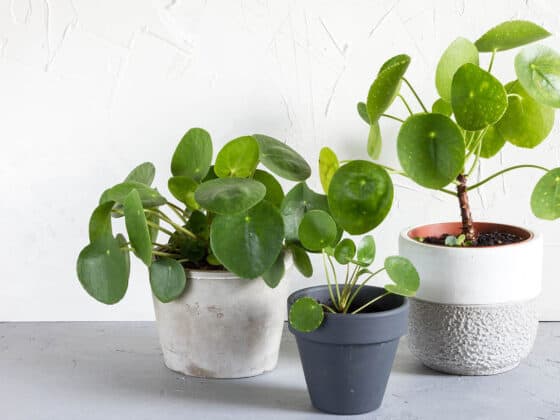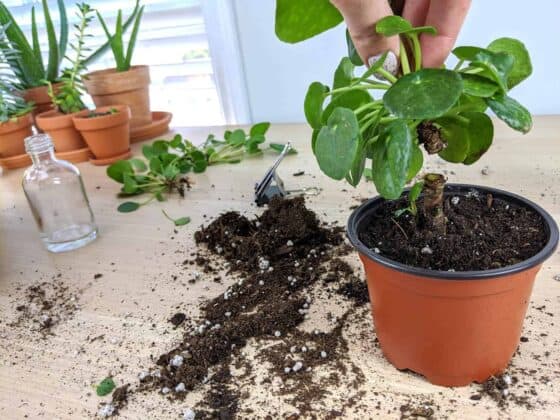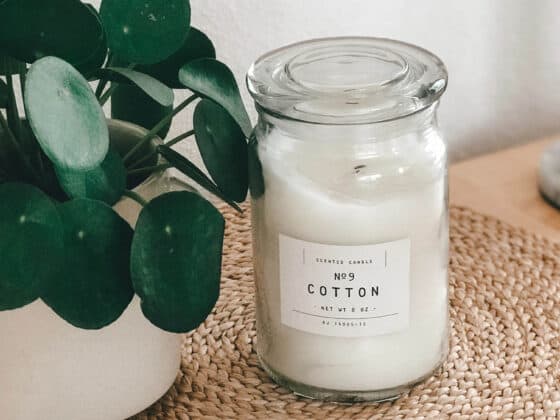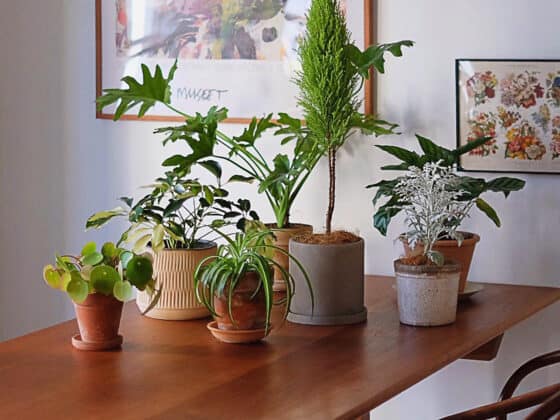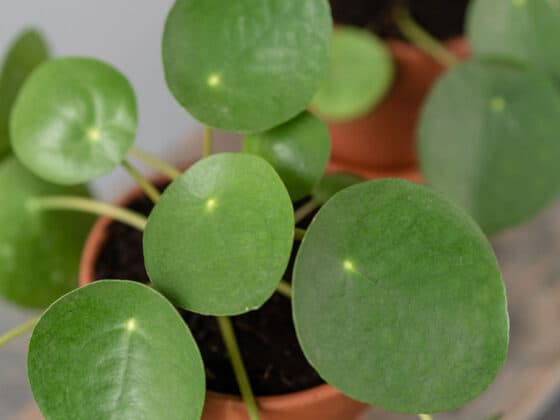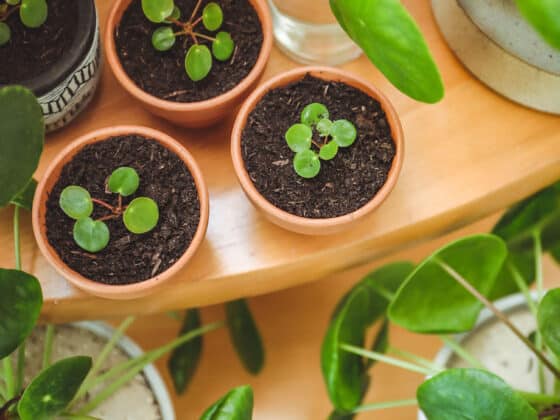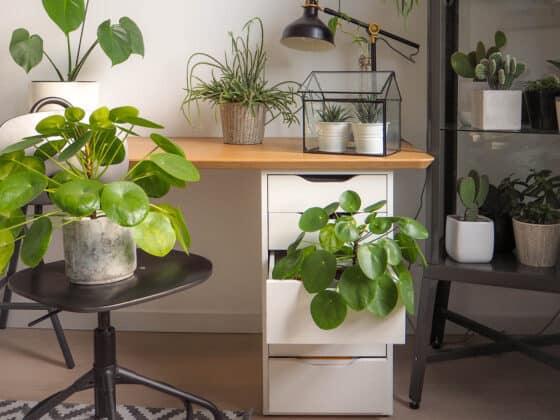Nothing makes me sadder than finding a houseplant I love in sorry shape, especially when it has come on quickly and I cannot understand why. Pileas are hardy plants, but even they can become victims of discoloration, legginess, leaf loss, and more. So what should you do when you find your Pilea like this?
The most frequent cause of unhealthy Pileas is over-watering. After that, common problems include not enough bright, indirect light, too much fertilizer, and nutrient deficiencies. It’s important to try to find the root cause of your Pilea’s ailment so that you can begin to take the steps needed to remedy the situation.
I’ve written this article to show you the most common types of problems Pilea owners face, the potential causes, and then the steps to recovering your plant. Below is a chart that should help you determine the cause of your Pilea’s symptoms. Next, you’ll find my best guess as to why your issue is happening as well as in depth information on the best steps to recovery.
What’s Wrong With My Pilea? Is My Pilea Dying?
When things start to go wrong with a houseplant you love, it can be completely nerve racking. So, like all good plant owners, you’ve turned to the internet to diagnose the poor guy. If your Pilea is less than healthy, use the chart below to try and determine the cause of your Pilea’s problem, then read the corresponding section further down for more information.
| Pilea Symptom | Potential Causes |
| Leggy/Etiolated | Not Enough Light |
| Losing Leaves | Overwatering or Old Age of Leaves |
| Pale Green or Yellow Foliage | Overwatering or Nutrient Deficiency or Sunburn |
| Brown Edges | Underwatering or Root Damage |
| Leaves Drooping | Overwatering/Poor Drainage or Underwatering |
| Leaves Curling | Overwatering or Stress from Heat/Cold or Not Enough Light |
| Brown Spots | Over-watering or Over-fertilizing or Fungal or Too Cold |
| White Spots | Mineral Deposits from Tap Water |
Is Your Pilea New to You?
I think it’s most important to start by saying that Pileas, like lots of other houseplants, are sensitive to changes in the environment. If your Pilea is new to you or has been recently moved, all your issues may be stemming from that. If you suspect that to be the case, don’t make it worse by moving it from place to place in your home. Also, allow it to completely dry out for a few extra days before watering it again.
If you suspect your problems are stemming from a change in environment, it is always best to wait a week or two before making any major decisions for your plant. Your plant will use that time to stabilize to its new environment.
However, if your plant is sitting in an area where it is being damaged, such as in direct sunlight, or near cold or hot drafts, like heating vents or doors, it is best to go ahead and move the plant to a more proper location. Then wait the week or two to see how it responds once it has become stable.
Proper Watering Habits for Pileas
Next, you should note that nearly every single problem on the chart above can be traced back to overwatering. Overwatering is not only the number one cause of discoloration, but also the number one cause of killing an otherwise healthy Pilea.
Pileas are members of the Urticacea family and are technically perennial, evergreen succulents. While they are different from many other species in the succulent family, they do have one thing in common with most – they hate to be overly wet.
The number one, quickest way to kill a Pilea Peperomioides is by keeping it too wet. Overly wet roots cause all sorts of problems for Pileas, from not allowing oxygen and nutrients to be absorbed to discolored, limp leaves and root rot. While these plants are extremely hardy, overwatering your plant will almost always send it to its grave.
Overwatering can actually occur in several different ways. The first, and most obvious, is that you provided too much water too frequently to your plant. However, overwatering can also be a result of poor drainage, which usually has to do with the container it is planted in, or the soil you’ve used to plant the Pilea.
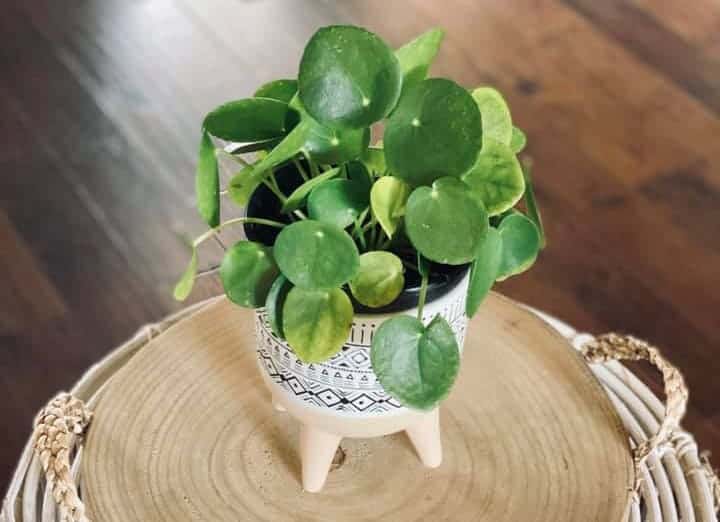
Pilea containers need to meet two requirements: they must have a drainage hole in the bottom and they must be the proper size. Containers without a drainage hole, or containers that are too large for the plant, both extend the amount of time it takes the soil to dry out between waterings. Pileas hate to sit in soggy soil and need to be planted properly to thrive.
Pileas should be planted in quick draining soil to aid in drying the soil out completely and quickly between waterings. I personally use succulent potting soil blends, but I know others who like to mix up something of their own. For more information on the best soil for your Pilea, click here to read an article I wrote on the subject.
Diagnosing Your Pilea Peperomioides
When it comes to an unhealthy Pilea, there are lots of questions that I hear over and over. These questions usually start with “Why is my Pilea…” and then contain a series of symptoms about the plant. What I’ve tried to do is to answer these most common questions with the most likely reason your Pilea is acting a certain way. Then I’ll provide you with what you should do about it to keep your plant as healthy as possible. So here we go!
Why Is My Pilea Leggy?
THE PROBLEM:
A leggy Pilea can be identified as a sparse plant with elongated stems that look droopy rather than the full, bushy, round shape we’ve all come to love. The scientific name for this is etiolation. Etiolated Pileas are very common. These Pileas have stretched out stems, a sparse central stalk, and smaller than normal leaves.
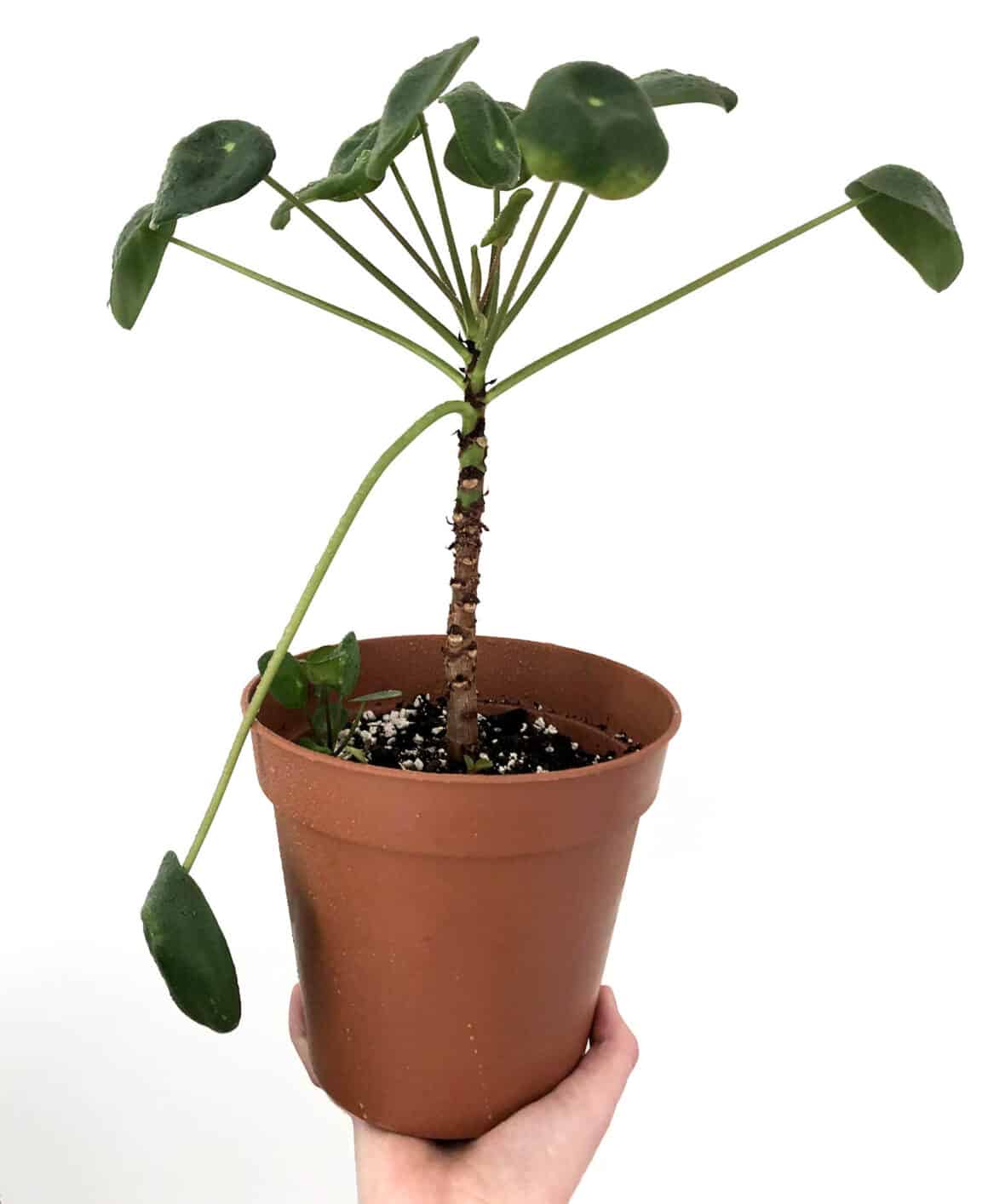
WHY IS IT HAPPENING?
ETIOLATION: All varieties of Pileas have a predisposition towards becoming leggy, or etiolated. Pileas become leggy when they don’t have access to bright enough light. Legginess is the result of your Pilea stretching to reach more light. Leggy plants have to change the way they grow to find more sun and often leaves a plant looking sparse.
The small leaves that are produced by a leggy Pilea are a result of the lack of energy in your plant. Plants constantly send out the energy they create through the photosynthesis process to their entire plant from root to leaves. For a leggy Pilea, most of that energy is being used to stretch and search for more light, which doesn’t leave enough energy for the plant to create large and healthy leaves.
THE SOLUTION:
ETIOLATION: The first step to fixing an etiolated Pilea is to move your plant to a brighter location. Pileas thrive with bright, bright light but beware! Direct light is too strong for your Pilea to handle. The best spot is near a sunny, south-facing window but far enough back that the sunlight will not land directly on your Pilea’s leaves.
If you don’t have an area to place your Pilea where it can receive the amount of bright light it needs, I recommend purchasing a grow light for your plant. Grow lights are specifically designed to mimic the sunlight your plant would receive outdoors and are excellent in assisting Pileas that don’t have enough natural light available to them. For more info on grow lights, visit this page.
For Pileas that have become extremely leggy, I often recommend chopping them in half, rooting the top portion, and replanting it. While this may seem scary, Pileas that have been topped like this often bounce back and both the bottom portion and the replanted top portion begin producing new growth in a matter of weeks. Chopping Pileas is a great way to give them a restart.
Why Is My Pilea Losing Leaves?
THE PROBLEM:
It’s incredibly sad to wake up to a leaf or two lying beneath your Pilea plant, but it is normal for the older leaves on your plant, specifically those at the bottom of the base, to droop and eventually fall off. This is a result of senescence and it happens as Pileas age. However, if most of your leaves are drooping, even the ones at the top of the plant, then you have a problem.
WHY IS IT HAPPENING:
AGING: If only a few of the bottom leaves of your Pilea are falling off, this is a result of senescence. Senescence is the aging of maturing plants, and as Pileas age their bottom leaves begin to droop and eventually fall off.
OVERWATERING: If more than a few leaves have fallen off or if you’re losing leaves in the middle of top of your Pilea, the most likely explanation is that your plant is overwatered. Overwatering happens not just when you give your plant too much water, but also when it does not have the ability to drain quickly.
THE SOLUTION:
AGING: If your plant is shedding leaves at the base as a result of its mature age, there is nothing to be done.
OVERWATERING: If you believe your plant is losing leaves from overwatering, you’ll need to adjust your watering habits. Pileas should only be watered when the top one inch of soil is dry. Also, they need to be planted in containers with drainage holes in the base and in a quick-draining soil.
If your plant has been overwatered, you may need to remove it from its container and set it on a baking rack to assist in drying the soil out more quickly.
For step by step instructions on saving an overwatered Pilea, click here.
Why Is My Pilea Turning Pale Green/Yellow?
THE PROBLEM:
While there may be problems going on under the soil with your Pilea’s root system, the best visual cue for diagnosing Pileas comes from the foliage. When Pilea leaves lose their deep green color and instead become pale or yellow, this usually points to one of three issues.
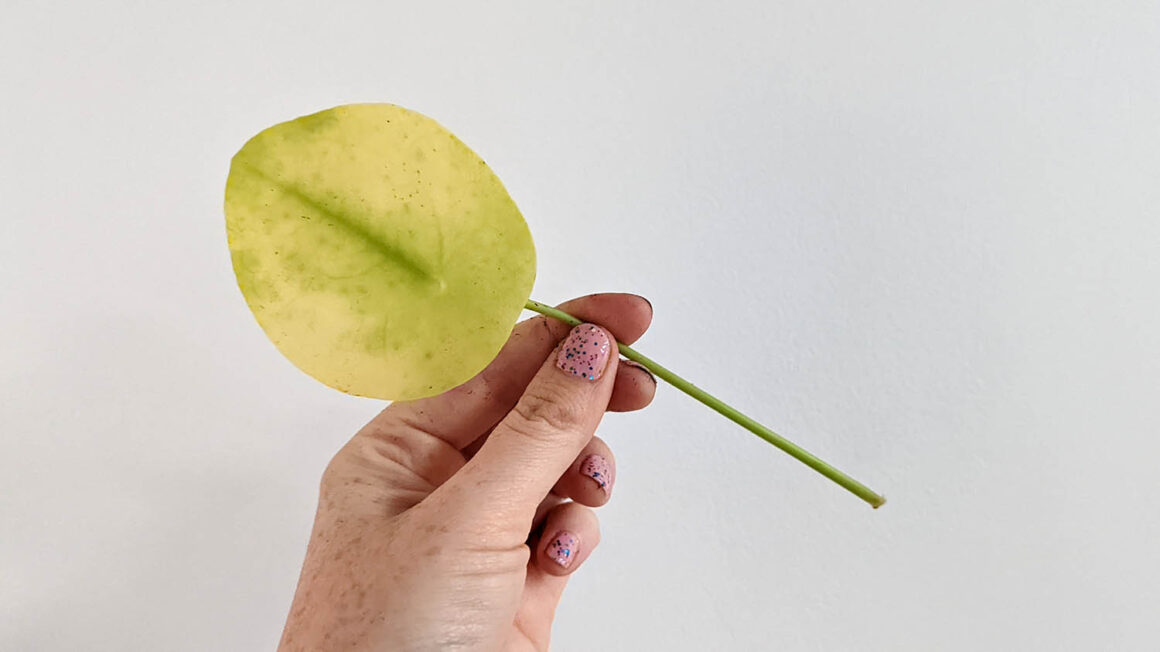
WHY IS IT HAPPENING:
OVERWATERING: The most common cause for discoloration in the foliage of your Pilea is overwatering. When Pileas’ roots systems are constantly overly wet, they stop being able to function properly and cannot absorb what they need or send nutrients to the rest of the plant. This is what causes pale green or yellow leaves.
NUTRIENT DEFICIENCY: If you are certain that you are not overwatering your plant and that it is draining properly, the cause of your yellow leaves may be a nutrient deficiency. When leaves do not have access to the nutrients they need from the soil, they can lose their bright color and start to fade.
SUNBURN: If the yellowing of your leaf is starting around the edges and working its way in, it could be the plant equivalent of sunburn. Pileas love bright light, but when exposed to it directly, they cannot tolerate it. Pileas who have been exposed to direct sunlight often begin to yellow on their leaves.
THE SOLUTION:
OVERWATERING: Make sure that your Pilea is planted in a container that is the right size, has a drainage hole, and is filled with quick-draining potting soil. Then, only water your plant when the top 1” of soil is dry. If your plant is extremely wet, you may need to remove it from its container to help it to dry out more quickly.
For step by step instructions on saving an overwatered Pilea, click here.
NUTRIENT DEFICIENCY: If your plant has been in the same pot for six months or more, it has most likely used up all the original nutrients that your potting soil was fortified with. In this case, you should consider adding fertilizer to your Pilea for additional nutrients. I use a 10-10-10 houseplant fertilizer diluted to half or even quarter strength on my Pileas once per month during their growing season.
For more information on fertilizing Pileas, click here.
SUNBURN: Move your Pilea to a new location that is out of reach of the sun’s direct rays. I like to put my Pileas on a table that sits back about three feet from a bright sunny window. In this spot, they are able to get lots of bright, indirect light.
For more information on the light requirements of Pileas, click here.
Why Is My Pilea Turning Brown
THE PROBLEM
Brown leaves are dying leaves and they are the last thing we want to see on Pileas. Foliage that is turning brown often starts at the tips and works its way inward.
WHY IS IT HAPPENING:
Brown leaves, or brown tips on the leaves of your Pilea, are a sign that your Pilea’s foliage is not getting enough water. This can be from underwatering or it can be a symptom of a damaged root system from overwatering or over-fertilizing.
UNDERWATERING: Not providing your Pilea with the adequate amount of water is the most obvious reason for brown, dried out leaves. When your plant doesn’t get enough water it cannot supply what it needs to its leaves.
ROOT DAMAGE: When the root system of a plant is damaged, it can no longer absorb water from the soil and push it out to its leaves. Root damage can be caused by fertilizer burn or from the root system being overly wet.
THE SOLUTION:
UNDERWATERING: Water your Pilea more often. You should water when the top one inch of soil is dry. If you cannot seem to keep your Pilea watered quickly enough, it may be a sign it needs to be repotted as the ratio beneath the soil is more roots than dirt.
For information on repotting Pileas, click here.
ROOT DAMAGE: When roots are severely damaged, they need to be pruned back. To prune the root system, you’ll need to remove the plant from its container, wash away as much soil as possible, and then clip the dark, mushy roots, leaving on the crisp white ones.
If you believe this is a result of overwatering, adjust your watering habits. If you believe it is from fertilizing, stop all fertilizing until your plant begins to show new growth again, and then only proceed with heavily diluted fertilizer.
For more information on pruning back roots, read this article about saving an overwatered Pilea – click here.
Why Is My Pilea Drooping?
THE PROBLEM:
Pileas have large round leaves on the end of long stems, which creates a beautiful, dome-shaped plant. But when those stems become weakened, the leaves begin to droop and Pileas start to look sad.
WHY IS IT HAPPENING:
OVERWATERING: The number one cause for drooping leaves is overwatering. Pileas can become overwatered when they have been given too much water too frequently or when they are not able to drain properly.
UNDERWATERING: Drooping leaves can also be a sign that your plant needs a drink. If the top inch of your soil has been completely dry for a few days and at that point the leaves begin to droop, it most likely just needs to be watered
THE SOLUTION:
OVERWATERING: Make sure your plant can drain properly. The container it is in should be just slightly larger than the plant itself and should contain a drainage hole. If your plant has been potted correctly, you’ll just need to adjust your watering schedule.
If you suspect your plant has been severely overwatered, read this article for a step by step guide to saving your overwatered Pilea.
UNDERWATERING: It is time to water your Pilea. Water thoroughly until about 20% of the water you put in runs out through the bottom drainage hole.
Why Are My Pilea Leaves Curling?
THE PROBLEM:
Pilea leaves should be round and flat, like a pancake, which explains its common nickname, “The Pancake Plant.” It is normal for the new growth of your Pilea to emerge curled at first, but it should flatten out as it grows. If you see lots of leaves on your plant curling, and not just the first few weeks of new growth, you have an issue.
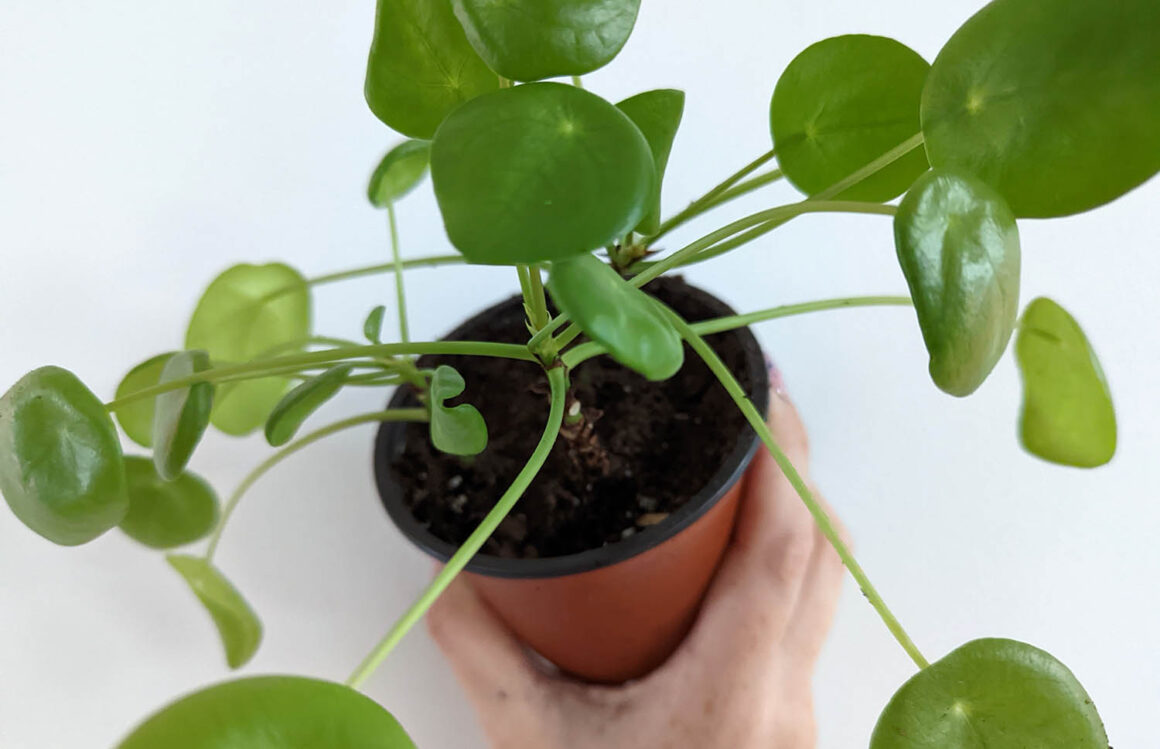
WHY IS IT HAPPENING:
OVERWATERING: Again, the cause of this problem is most likely from overwatering or poor drainage within your pot. Overwatering is the most common issue with Pileas and curled leaves are often a symptom of this.
STRESS: If your plant has been placed in a drafty area where it is receiving quick blasts of overly hot or cold air, this could cause the plant’s leaves to curl. Also, this stress can be a result of the overall temperature of the room or from being placed in an area that is too hot or cold within your home.
NOT ENOUGH LIGHT: Sometimes Pileas cup, or curl, their leaves in an attempt to maximize the surface area they have for absorbing light. This happens when Pileas do not have access to enough bright, indirect light.
THE SOLUTION:
OVERWATERING: If you believe you’ve overwatered your Pilea, you’ll need to adjust your watering habits. Pileas should only be watered when the top one inch of soil is dry. Also, they need to be planted in containers with drainage holes in the base and in a quick-draining soil.
For step by step instructions on saving an overwatered Pilea, click here.
STRESS: The best environments for Pileas are areas that are between 65-75° F and are out of reach of any cold or hot drafts coming from doors, windows, and heating/cooling vents. If your Pilea is stressed by its current location, try moving it to a place that meets these requirements.
NOT ENOUGH BRIGHT LIGHT: Move your plant to a brighter location. Pileas thrive with bright, bright light but beware! Direct light is too strong for your Pilea to handle. The best spot is near a sunny, south-facing window but far enough back that the sunlight will not land directly on your Pileas leaves.
If you don’t have an area to place your Pilea where it can receive the amount of bright light it needs, I recommend purchasing a grow light for your plant. Grow lights are specifically designed to mimic the sunlight your plant would receive outdoors and are excellent in assisting Pileas that don’t have enough natural light available to them. For more info on grow lights, click here.
Why Does My Pilea Have Brown Spots?
THE PROBLEM:
Pileas should have big, deep green leaves and stems. When your plant starts to develop spots on the leaves, this is concerning. Brown spots can be caused by a number of things, here are the four most common reasons.
WHY IS IT HAPPENING:
OVERWATERING: Again, overwatering could be the cause of your problem. With any discoloration on Pilea leaves, my first inclination is to always check the amount of water the plant is receiving. Overly wet plants have damaged root systems, and damaged roots systems can cause a number of problems, including not being able to supply your plants leaves with what they need to be healthy.
OVER FERTILIZING: Fertilizer can be a great growth boost for your Pileas when it is administered correctly. Administered incorrectly and it can burn your plant. This burn shows up in the form of brown spots on the leaves but usually goes even deeper and has damaged your root system as well.
FUNGAL ISSUES: Fungus can be nasty and, if left unchecked, can kill a Pilea. Usually fungal problems go hand in hand with overwatering, as they are often the result of a plant being overly wet for too long. Musty odors from the soil or visible mold around the base are other common symptoms of fungal issues.
SCARRING FROM COLD: Pileas are tropical plants and should be kept in temperatures between 65 – 75° F. If they get too cold, sometimes this leaves a mark on the plant in the form of brown spots.
THE SOLUTION:
OVERWATERING: Adjust your watering habits and make sure that your Pilea is planted in the proper container. If your plant is overly wet, you may need to remove it from its container and set it on a baking rack to help it dry out more quickly.
If you are worried you’ve nearly killed your plant with overwatering, read this article on Saving an Overwatered Pilea.
OVER FERTILIZING: Pileas who have been burned by fertilizer need to be allowed to fully heal before ever being fertilized again. You can check the root system of the plant and may need to prune them back if they are brown or mushy, leaving only the white crisp roots
Once the plant is showing signs of new growth, you can resume your fertilizing schedule. Fertilizer should always be diluted for Pileas to half or quarter strength and plants should only be fertilized once per month and only during their growing season. For more information on fertilizing Pileas, click here.
FUNGAL ISSUES: Fungal issues will usually affect the roots below the surface, as well as cause discoloration in your leaves. First, examine your roots to see if they need to be pruned. Roots that are brown and mushy should be completely cut back. Repot your Pilea in new soil and treat with a mild fungicide solution.
SCARRING FROM COLD: If your Pilea is near a cold window, door, or cooling vent, you should immediately relocate the plant to a safer area. Pileas like bright, indirect light and indoor temperatures between 65-75° F.
Why Does My Pilea Have White Spots?
THE PROBLEM:
Many Pilea owners become alarmed when they notice small, white dots on the underside of their Pileas. These dots look like little, white pinpricks and they can be wiped away with a warm cloth.
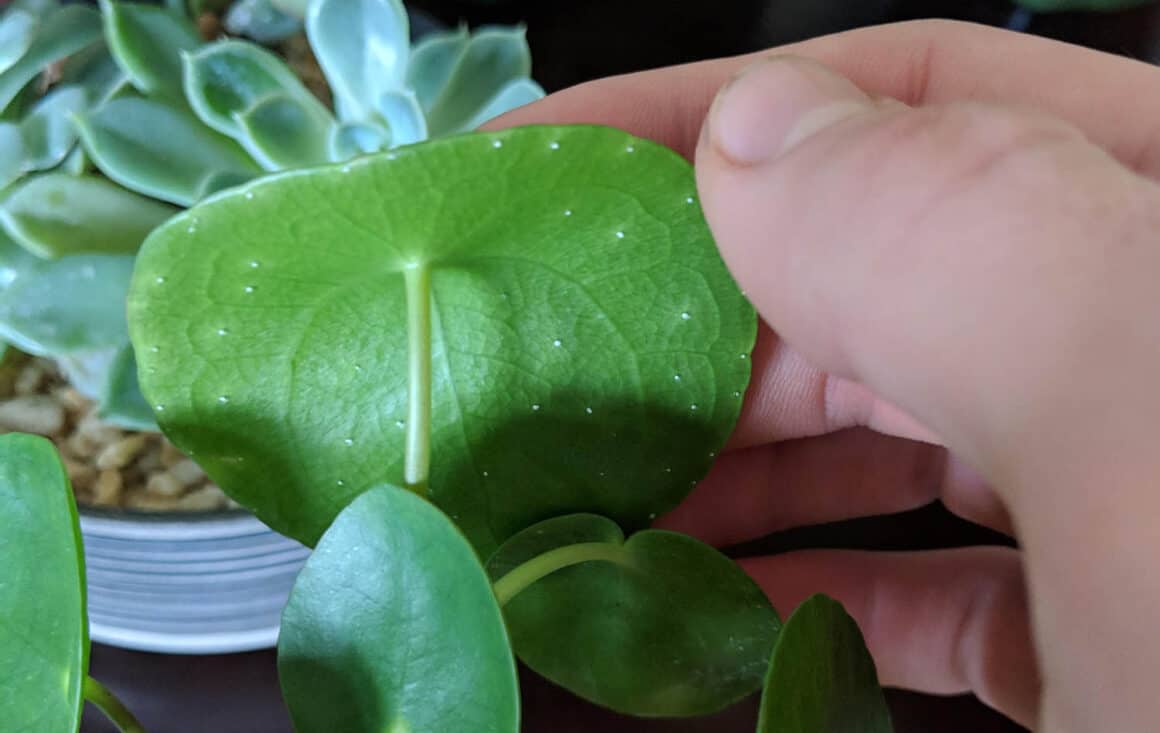
WHY IS IT HAPPENING:
MINERAL DEPOSITS: Pileas develop these small white dots when they have been watered with tap water. Tap water contains minerals that your Pilea cannot process. When it releases the water vapor as a result of its photosynthesis process, these minerals get released as well and appear as small, white dots on the underside of Pilea leaves.
THE SOLUTION:
MINERAL DEPOSITS: These white dots will not harm your Pilea, but they should be wiped away to help keep the pores of the plant clear. To keep them from appearing in the future, switch to watering your Pilea with distilled water or leave the tap water out in an open container overnight (this will allow the chemicals within to evaporate before using them on your plant).
Diagnosing Your Pilea and Choosing The Steps to Recovery
As you can see, one symptom may stem from a number of underlying causes. This often makes it difficult to pinpoint exactly what is happening with your Pilea. I recommend finding what you believe is the most likely cause and then making those small changes. Then give them time to show results before moving on and trying something else.
Overwatering is the most common cause of issues with a Pilea and because of that, I would always recommend you start by adjusting your watering schedule. If you are completely certain that you are not overwatering your plant, then move on to the next logical explanation.
How to Save an Overwatered Pilea
Depending on the level of damage that has been done to your Pilea with overwatering, it is sometimes possible to reverse the effects. In short, you will need to completely dry out the plant, cut back any damaged roots, and replant the Pilea in a proper container.
If you believe your plant can be saved, read this article I wrote as a step by step guide to saving an overwatered Pilea.
